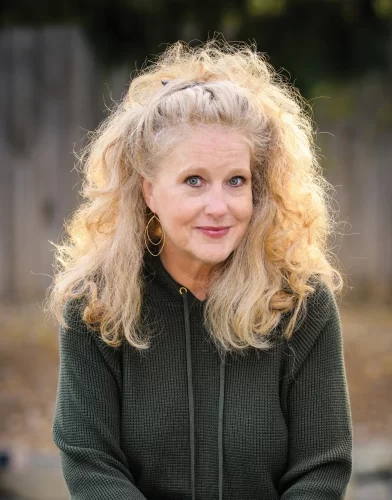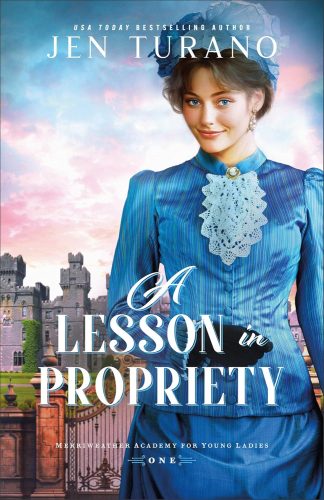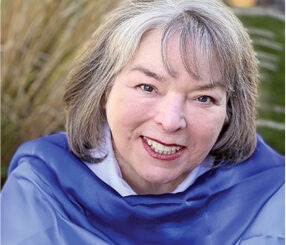 Jen Turano
Jen Turano
https://jenturano.com/
Read the review for A Lesson in Propriety here
T4JYM: Can you tell us about your latest book and what readers can expect from it?
JT: “A Lesson in Propriety” is my first book in the Merriweather Academy for Young Ladies series. It’s a bit of a madcap adventure, complete with an overly proper New York society lady, a castle that’s rumored to be haunted, unscrupulous developers, a delightful gentleman who’s been surrounded by ladies his entire life (which is why he understands them so well) and a cast of quirky creatures, including a trio of attack-ferrets, guard goats, and a duck that thinks it’s not a duck.
T4JYM: What comes next? Are you working on something new?
JT: I recently turned in what are known as developmental/content edits for the second book in this series, “In Pursuit of Civility.” It follows the story of Annaliese Merriweather, a lady who teaches decorum lessons at an academy she partially owns, but who isn’t exactly the best decorum instructor as she makes it a habit to misplace her students. I only have two more steps to complete on that story – copy/line edits, and then final display pages. I’ll also be sharing the cover for that soon, and it’s absolutely delightful. Besides that, I’m also writing the third and final book in the series, “A Dash of Decorum.” It’s coming along relatively well, but I don’t actually enjoy writing first drafts – all those pesky blank pages staring at me every day – so I tend to get a tad grumpy.
T4JYM: How do you describe your writing style? What sets you apart from other authors?
JT: I’m what’s known as a conversational author, meaning the majority of my book revolves around the characters speaking to each other. Because I write comedy, this is the best style for me to be able to move the humor along quickly, and is also why I don’t include many descriptions or a lot of imagery as that would slow the pace of the book down. Comedy is all about the rhythm, quite like a song, and if I get that rhythm wrong, the amusement will fall flat.
T4JYM: How much time and research goes into a book? And how do you ensure they are accurate?
JT: That depends on where I decide to set my story. All my books take place during the Gilded Age, and when I first started out, they were set in New York City. I had to do a great deal of research in the early days so that I understood New York high society, and had a grasp of what a New York street, along with the houses there, would look like. I also had to research all the different industries where men were making their fortunes. That allowed me to give the reader a glimpse of the times, but only a glimpse. The tricky part for me has always been not overloading the story with what I call a history dump. Yes, I want the readers to be able to visualize what Arnold Constable & Company, one of the early department stores, looked like, but I don’t need to include all the details I found about that store in the story.
These days, if I set a story in New York, the research isn’t as intensive as I already know a great deal about that city. However, in this new series, I’ve moved my characters to Chicago, and while I have taken a few characters to that city in some of my older books, I had to get new research books, all of which dealt with the mansions in Chicago, the leaders of Chicago society, such as Bertha Palmer, and also Lake Shore Drive, where I created the castle that becomes the Merriweather Academy for Young Ladies.
 T4JYM: Will you describe your writing process, from the spark of an idea through writing it, editing, and finally to publishing?
T4JYM: Will you describe your writing process, from the spark of an idea through writing it, editing, and finally to publishing?
JT: I keep a box with potential stories where I just toss ideas as they come to me. Usually, I find a spark while doing research for whatever book I’m currently writing. I then jot down the idea, and when I’m ready to submit a new proposal to my editing team for a new series, I pull out the box, go through the notes, and hopefully something jumps out at me. It’s not until characters start to evolve in my head, meaning I can distinctly see them, or better yet, start talking to me, that I know which idea I’m going to move forward with. After that, I start writing a synopsis, which I turn over to my editors, even though, after I get started on a story, it rarely resembles anything I first thought about. I’m what’s known as a hybrid author, meaning I don’t plan out the entire story, only five chapters at a time, because my characters are always changing things up and if I plan out more than five chapters, it turns into a waste of my time as my characters rarely want to follow what I want them to do.
After I finish a first draft, which I have a specific process for that includes editing it seven times, I turn that over to my editing team, they read it, then send me back their suggestions. Those suggestions are always spot on, whether it’s suggesting I expand on a specific scene, or cutting a chapter that’s dragging, which means I usually end up rewriting a good portion of the original story. I then turn that in, it goes to copy/line editing, I go through that once I get it back, make changes, send it in, and then I finally get final design pages, which are super easy to get through because, at that point, I’m mostly looking for typos. I then turn that in and never read that story again.
T4JYM: What advice would you give to someone interested in publishing their work?
JT: That every writer needs to realize that publishing is a daunting business, and that rejections are just part of the game. It took me seven manuscripts and five years before my work got to what I now call ‘publishing worthy.’ Most times, our early stories are simply not good enough to go out into the world, so don’t rush it. I look at those early manuscripts as my stepping stones, and stones that allowed me to polish my craft and grow as a writer, finally getting to where I was good enough to land a literary agent, who then very kindly sold my work to a publisher.
T4JYM: What advice would you give to the youth of this world?
JT: To remember that being kind is cool, and to always stick up for those less fortunate.








Be the first to comment